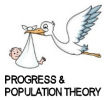 Van Badham, the author of an insulting Guardian piece against Dick Smith, (Thursday 7 September 2017) parades the usual cliches about 'educating women' to deal with population growth, despite the obvious fact that although women in Australia still have relatively high rates of literacy, our population just keeps growing faster and faster. Not because Australian women are having huge families, but because mass immigration from overseas contributes 60% of Australia's population growth. How is education going to fix that, Ms Van Badham? [16 September 2017: See new footnote #5.]
Van Badham, the author of an insulting Guardian piece against Dick Smith, (Thursday 7 September 2017) parades the usual cliches about 'educating women' to deal with population growth, despite the obvious fact that although women in Australia still have relatively high rates of literacy, our population just keeps growing faster and faster. Not because Australian women are having huge families, but because mass immigration from overseas contributes 60% of Australia's population growth. How is education going to fix that, Ms Van Badham? [16 September 2017: See new footnote #5.]

Not progress
Most people in Australia and the rest of the Anglosphere are educated to believe in a sort of chronological continuous improvement, which they know as 'progress'. This 'progress' explanation is used to excuse all kinds of costs imposed by change. (We also hear, 'Change is good'). But much coercive and costly change is caused by catering to overpopulation and overdevelopment, and both these ills are engineered by powerful people. Over the last 20 years in Australia, the mainstream media has represented the growth lobby by pushing rapid population growth as an economic norm, as an inevitable demographic fact, and has played its only card - the race card - against the many more rational objections.
Rent a troll
With the rise of the internet, the beneficiaries of engineered population growth use crowds of trolls to defend these costs and the growth lobby's excesses on the internet, so that when critics of rapid population growth go to 'progressive' sites that push growth, they will get all kinds of flack. The trolls are designed to frighten questioners away. People should not be misled to believe that the nasty attacks on people who question population growth are sincere - they are too similar and irrational to be spontaneous - but they do need to be countered.
A recent and gross example have been a majority of comments on an article, "I get why you're angry, Dick Smith. The ABC ignores my ideas all the time," in The Guardian (Thursday 7 September 2017) about Dick Smith's ad against massive population growth. You can see these comments here: https://www.facebook.com/theguardianaustralia/posts/1487301447971603. Many are grossly defamatory. [Revisiting the site two days later, I discover that, thankfully, many of these awful comments have been unpublished by The Guardian.] The article itself, although it is apparently by a professional journalist, is sarcastic, coarse, superficial and ageist, characterising Smith as sexist, a white man abusing his traditional privilege, an elderly xenophobe having a 'brain fart'.
Female education in Australia
The author of this gratuitously insulting piece, Van Badham, then parades the usual cliches [1] about 'educating women' to deal with population growth, despite the obvious fact that although women in Australia have relatively good (if deteriorating) educations, our population just keeps growing faster and faster. Not because Australian women are having huge families, but because mass immigration from overseas contributes 60% of Australia's population growth. How is education going to fix that, Ms Van Badham?
Don't let the facts stand in the way, Ms Badham
Immigration is a factor totally ignored by the so-called Demographic Transition 'theory'. Speaking as a population scientist, I would say that Dick Smith is on the right track and Ms Van Badham is ignoring 60% of the equation. However you will find that most Australian 'population experts' - read professional 'demographers' and friends of the growth lobby - also fall for the Badham arithmetic mistake, although they are all more mathematicians and economists than scientists.[2] They fall for it because they do not test it and they do not read around it or anything not produced in English.
Outside the Anglosphere bubble
It was to educate people with open minds that I translated Etienne Van de Walle's: “French fertility in the 19th century,” which you can read here: /node/4247. Van de Walles was not the only French population historian and demographer to write about how France had 'its demographic transition' before industrialisation, right after the Revolution. The Anglosphere is known for ignoring theories that question its own tenets, however, so no-one hears about it.
One brave American population historian, Paul G Spagnoli, dared to write about this strange turning away from scientific method in the Anglosphere, which is so dominated by political and economic ideology. You can read his paper, "The unique decline of mortality in revolutionary France,"(1997) here: https://www.ncbi.nlm.nih.gov/pubmed/11619481. Almost no-one paid attention to this eminent bilingual historian's significant analysis, because it did not suit the anglosphere bias.
Anyone talking population needs to know this
Seuil, France also published a multi-article review by population theorists which included Dupâquier and other notables, as Communications, 44, 1986. Dénatalité : l'antériorité française, 1800-1914., (1986).[3] The meaning of the title is "Fall in the birth rate: the French precedent, 1800-1914." There was both a fall in the birth rate and a fall in mortality, at the same time as there was a rise in marriages, a fall in age of marriage, and a decline in never-marrieds! Why? Well, the French used contraception - but they didn't need the pill; they used the sheath, withdrawal, and various pessaries. Contraceptives have been known forever,[4] but using them demands a will to do so. In the 19th century, as the state cracked down on use of contraceptives because they wanted more soldiers for war, bands of French activists went round the country selling them and teaching people how to use them, especially poor people in cities. (See Francis Ronsin, La Greve des ventres, Aubier, France, 1980.)
Prior to the French Revolution, France's population was either stable or grew very slowly. [5] Although forms of contraception have been available extending back into ancient history, this Ancien Regime population stability is thought to have been due to a different kind of population control, where quite high percentages of people never married, never had children, and where the average age of marriage was quite high (over 25 yrs old). People who did marry and have children averaged above 5 children and life expectancy was low, with many children dying in infancy.
The natural fertility myth and endogamy
The French demography historians, such as Jacques Dupâquier (who calls it a myth) and Henri Leridon, also question the so-called 'natural fertility' concept which Anglosphere demographers believe is demonstrated by the extreme fertility of the Hutterites. See, Bardet and Dupâquier, "Contraception: les Francais les premiers, mais pourquoi?" in the abovementioned Dénatalité : l'antériorité française, 1800-1914. Dupâquier and others refer to the power of endogamy in determining fertility opportunity. The French and most tribal people before colonisation, globalism, and the car, were endogamous. That is, they lived in villages (the equivalent of clans or tribes) where only rarely did anyone marry far beyond the village or tribe. Because of the small range of population numbers within a village or tribe this meant that, like a small game of musical chairs, not everyone would find a marriagable partner, either because they were too strongly related or because all possibles were already married or because they were outside their social class (homogamy).
Another brake on fertility was that lack of housing or a good income made people less attractive as marriage partners.
Transport and the Post-WW2 Baby Boom
The advent of relatively cheap cars brought about a sudden jump in the marriage and birth rates in many countries because people could live in new houses in places that had previously been too far from work and ammenities and they found employment in the post war fossil fuel economy. Hence more people became marriagable. This was called the "Baby Boom." Trains had also made a difference to employment opportunities and the viability of living in once out of the way places. Boats early brought marriagable strangers closer. Planes exploded trans-ocean marriage/fertility opportunities. The latest accelerator of marriage and fertility opportunity is probably the internet which permits romances that are detached from real circumstances.
Colonisation, industrialisation and war accelerate population growth
However the problem of mass immigration remains an accelerant of population growth that is rarely acknowledged, although those who make open borders policy know it well. They just don't talk about it. Just think of how colonisation and war, by exploding endogamous traditions and driving people from their historic villages and tribal lands to cities in search of work has affected India, China, Africa, the Middle East ... Think how it has affected Australia - once occupied by a much smaller lighter footprinted population for 60,000 years. How much difference will the wars pushing people from Africa and the Middle East and the politicians inviting them to enter Europe's almost stablising population make? How much more will the globalisation of everything and open borders accelerate all populations and anihilate all diversity?
About the author
The author of this article, Sheila Newman, is an evolutionary sociologist specialising in population, environment and energy resources. Relevant to the theory expressed here, she has published, Demography, Territory, Law: The Rules of Animal and Human Populations, Countershock Press, 2012 See peer reviews and explanation here) and Demography, Territory, Law 2: Land-tenure and the origins of capitalism in Britain, Countershock Press, 2014 and she is currently working on the third volume in series, Demography, Territory, Law 3: Land-tenure and the origins of democracy in France. Her major thesis in Environmental Sociology, which included oil economics, was The Growth Lobby in Australia and its Absence in France, 2002. For where to buy these see her bio here: /node/1882
NOTES
[1] [My translation]: "In researching factors to explain differences in fertility between different states in India, two authors proposed analyses based on the same methodology, multiple regression, focusing on each state. Zachariah and Patel (1984) concluded that a small number of socioeconomic variables (with the level of education achieved by women at the top) explained 91% of variation in birth rates. Jain in 1985 concluded in a similarly convincing fashion (explaining 90% of variation) that it was due to three major variables: age at marriage, infantile mortality, and use of contraception. Thus, each one could boast of having identified the key variables to Indian fertility, but both lists of variables were completely unrelated! We can understand why: both lists were not independent and the socioeconomic variables identified in the first article affected the variables taken into consideration in the second. Source: Henri Leridon, "Théories de la fécondité : des démographes sous influence ?", Population 2015/2 (Vol. 70), p. 331-373. DOI 10.3917/popu.1502.0331, pp. 336-337.
[2] Henri Leridon, "Théories de la fécondité : des démographes sous influence ?", Population 2015/2 (Vol. 70), p. 331-373. DOI 10.3917/popu.1502.0331, pp. 334, 'Not theories but ideas.'
[3] Under the direction of the School of Higher Studies in Social sciences - Centre of Transdisciplinary Studies (Sociologie, Anthorpologie, Politics).
[4] John Knowles (Lead author), Report, "History of Birth Control Methods," Katharine Dexter McCormick Library and the Education Division of Planned Parenthood Federation of America, 2012, http://www.plannedparenthood.org/files/2613/9611/6275/History_of_BC_Methods.pdf
[5] Note from Sheila Newman 16 September 2017: I originally wrote that the population of the Ancien Regime 'was also stable for a couple of centuries'; I am ammending this to take into account a revised opinion in France, which is that the population may have grown very slowly. Also, after the French Revolution, France's population did grow, of course, despite a lower birth rate, because of the reduction in the death rate, the increase in marriages and the decrease in celibacy. I have not yet adequately researched whether the role of immigration in increasing growth rates was significant during the Revolution. Note that most documents of the Ancien Regime (such as they were) were lost during the French Revolution and estimating population size during that time, and growth, is not very reliable. With regard to the recent ammendment from two or more centuries of population stability (rather non-growth, due to huge demographic crises such as recurrent epidemics, wars and famines (famines were often related to wars and the depredations of soldiers on local food crops) to 'slow growth'; it is difficult to find the origin of this 'recalculation' and one wonders if it was not a political or a population-theory decision where, on a basis that the leap from estimates of 18-20 or 22m French until 1750 seemed too sudden compared to the first modern census of 1801, which found 29,361,000 people in France. The alternative to this would be to re-guess the population of France under the Ancien Regime at around 25 or even 27 million. This would then run up hard against the 18m estimated by Vauban at the end of the 17th century. That estimate was based on poll taxes by household.

 Today Australian Federal Parliament voted down Independent Senator David Pocock's motion to establish a Select Committee on Population Impacts to inquire into the effect of population growth and management in Australia. Pocock has a background in sustainable agriculture and sport. Consider lobbying your member of Federal Parliament to help him move the motion again.
Today Australian Federal Parliament voted down Independent Senator David Pocock's motion to establish a Select Committee on Population Impacts to inquire into the effect of population growth and management in Australia. Pocock has a background in sustainable agriculture and sport. Consider lobbying your member of Federal Parliament to help him move the motion again. Australia’s population of 26.5m grew at the rate of 2.2% (year ending March 2023.) At 2.2% growth rate our current population would increase to 30m within 10 years and double in 31.85 yrs and would reach 150m by 2103, within the life-expectancy of a child born today. Less than 25% of that 2.2 rate of population growth was due to natural increase. Without the 454,361 migration, we would have grown at about 0.55%.
Australia’s population of 26.5m grew at the rate of 2.2% (year ending March 2023.) At 2.2% growth rate our current population would increase to 30m within 10 years and double in 31.85 yrs and would reach 150m by 2103, within the life-expectancy of a child born today. Less than 25% of that 2.2 rate of population growth was due to natural increase. Without the 454,361 migration, we would have grown at about 0.55%. Where To From Here - Victorian Local Government Elections 2024; Save Our Canopy Trees – April 1 Forum; Planning and Heritage Inquiry; Level Crossing Removal FOI; VCAT Protest?; Let There Be Light – Brunswick Residents Have a Win; Planning Scheme Amendment St Phillip St Brunswick East; Guest Speaker at Fitzroy Residents Association; John Curtin Hotel; Royal Exhibition Building and Carlton Gardens; Western Port Woodlands Alliance Formed; MAB Attempts to Silence Westmeadows Re
Where To From Here - Victorian Local Government Elections 2024; Save Our Canopy Trees – April 1 Forum; Planning and Heritage Inquiry; Level Crossing Removal FOI; VCAT Protest?; Let There Be Light – Brunswick Residents Have a Win; Planning Scheme Amendment St Phillip St Brunswick East; Guest Speaker at Fitzroy Residents Association; John Curtin Hotel; Royal Exhibition Building and Carlton Gardens; Western Port Woodlands Alliance Formed; MAB Attempts to Silence Westmeadows Re Australia's high density buildings are not designed to mitigate the spread of a virus as they have poor air circulation, insufficient balconies, and are usually designed for people who are away all day and only home to sleep. Our cities do not have enough open space areas for residents in high density apartments to escape to, yet we are still inundated with business and media statements extolling the benefits of population growth that can be accommodated in ever higher densitie
Australia's high density buildings are not designed to mitigate the spread of a virus as they have poor air circulation, insufficient balconies, and are usually designed for people who are away all day and only home to sleep. Our cities do not have enough open space areas for residents in high density apartments to escape to, yet we are still inundated with business and media statements extolling the benefits of population growth that can be accommodated in ever higher densitie Any new inquiry into Australia’s migration program needs to assess the full costs and benefits of population growth, especially the costs to our environment and the risks of collapse. I wish I had a dollar for every pro-population-increase article I have read that begins by telling the reader that Australia is a nation of immigrants, with some 25% born overseas and about 50% with at least one parent born overseas.
Any new inquiry into Australia’s migration program needs to assess the full costs and benefits of population growth, especially the costs to our environment and the risks of collapse. I wish I had a dollar for every pro-population-increase article I have read that begins by telling the reader that Australia is a nation of immigrants, with some 25% born overseas and about 50% with at least one parent born overseas. “About one in 25 Australian homes are at high risk of becoming effectively uninsurable by 2030, according to a new Climate Council report based on analysis by a climate risk assessment group (ABC, 2022).” (Dr Peng Yew Wong, RMIT School of Property.)
“About one in 25 Australian homes are at high risk of becoming effectively uninsurable by 2030, according to a new Climate Council report based on analysis by a climate risk assessment group (ABC, 2022).” (Dr Peng Yew Wong, RMIT School of Property.)
 Sustainable Population Australia (SPA) believes there is nothing to fear from the downward projection of population size in the Inter-Generational Report (IGR) from 40 million to 38.8 million by 2061. National President Jenny Goldie says what is to be feared are the environmental, social and economic cost of adding another 13 million people to the population.
Sustainable Population Australia (SPA) believes there is nothing to fear from the downward projection of population size in the Inter-Generational Report (IGR) from 40 million to 38.8 million by 2061. National President Jenny Goldie says what is to be feared are the environmental, social and economic cost of adding another 13 million people to the population. I think it is timely to highlight the fact that HRH Duke of Edinburgh appears to have had a pretty good understanding of environmental issues and the role of human population numbers in environmental degradation.[1] His reputation for having a curmudgeonly persona went before him, and possibly gave him licence to blurt out his thoughts, uncensored by notions of political correctness. His gratuitous remarks to more or less strangers, regarding their appearances, or rude questions, characterised his multitudinous "gaffes". He was refreshingly "un careful" and honest in interviews, so he spoke of what many refer to as "the elephant in the room" - human population numbers - as though this reality was indeed not only visible but very obvious.[2] He remarked in one interview that where humans are, there is nothing else (!) He was unmeasured in his comments, so his message was clear. He also remarked, in one interview, that no-one wants to talk about it [population]. I have not, so far, found an interview where any interviewer delves deeply into this with him.
I think it is timely to highlight the fact that HRH Duke of Edinburgh appears to have had a pretty good understanding of environmental issues and the role of human population numbers in environmental degradation.[1] His reputation for having a curmudgeonly persona went before him, and possibly gave him licence to blurt out his thoughts, uncensored by notions of political correctness. His gratuitous remarks to more or less strangers, regarding their appearances, or rude questions, characterised his multitudinous "gaffes". He was refreshingly "un careful" and honest in interviews, so he spoke of what many refer to as "the elephant in the room" - human population numbers - as though this reality was indeed not only visible but very obvious.[2] He remarked in one interview that where humans are, there is nothing else (!) He was unmeasured in his comments, so his message was clear. He also remarked, in one interview, that no-one wants to talk about it [population]. I have not, so far, found an interview where any interviewer delves deeply into this with him. Amazing isn’t it? The federal government sets immigration policy. And yet the immigration minister can’t even answer the most simple of questions.
Amazing isn’t it? The federal government sets immigration policy. And yet the immigration minister can’t even answer the most simple of questions.
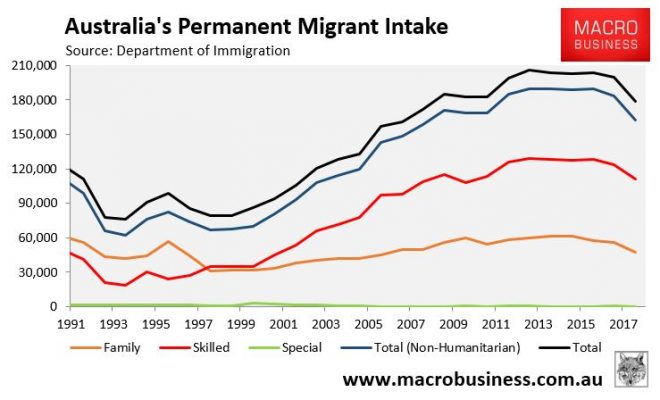
 Van Badham, the author of an insulting
Van Badham, the author of an insulting 
 Article by Leith van Onselen. Dick Smith is a national treasure. Yesterday he used his own money to fund an ad in Australia’s major newspapers challenging Lucy Turnbull – the chief commissioner of the Greater Sydney Commission (GSC) – on mass immigration, and asking her what her eventual plans are for the population of Sydney – querying whether it could be 16 or even 100 million.
Article by Leith van Onselen. Dick Smith is a national treasure. Yesterday he used his own money to fund an ad in Australia’s major newspapers challenging Lucy Turnbull – the chief commissioner of the Greater Sydney Commission (GSC) – on mass immigration, and asking her what her eventual plans are for the population of Sydney – querying whether it could be 16 or even 100 million.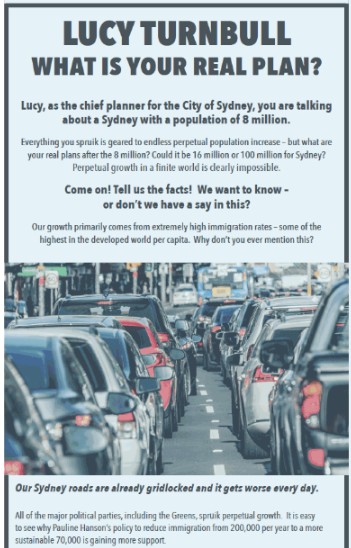

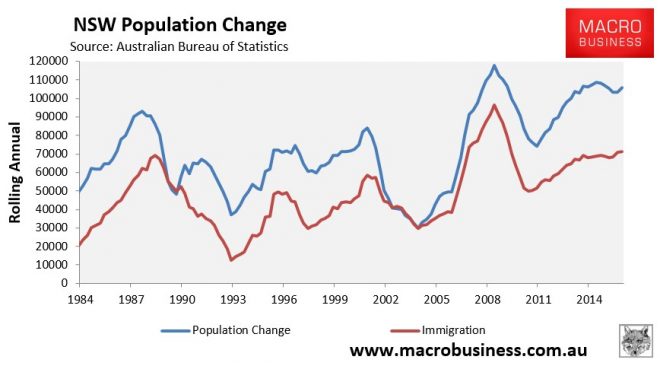
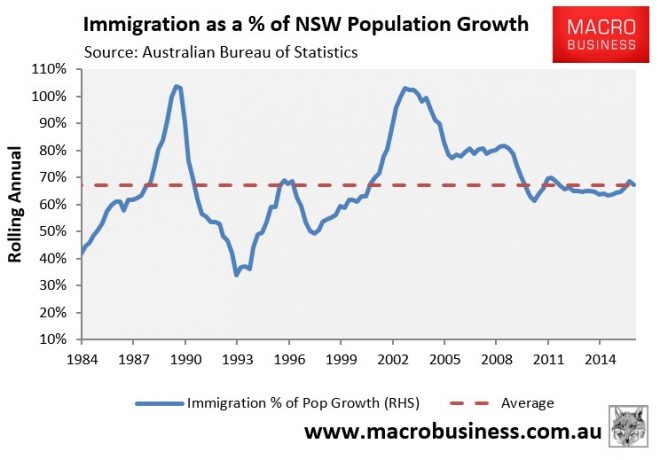
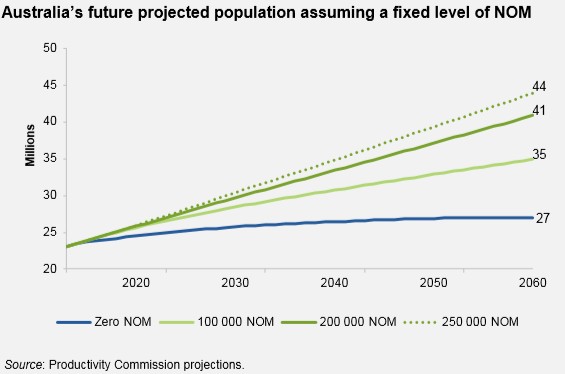
 "Mark, I am fully aware that your job must be challenging and frustrating at times, but ignoring the elephant in the room – the increasingly obvious negative impacts of population growth - is putting EV and all who care for our environment on a never ending hamster wheel of frustration, disappointment, and ultimately hard earned campaign money down the gurgler. Unchecked population growth is having a ratchet effect, steadily increasing the pressure on the environment and reversing previous efforts to protect it. " (Jenny Warfe)
"Mark, I am fully aware that your job must be challenging and frustrating at times, but ignoring the elephant in the room – the increasingly obvious negative impacts of population growth - is putting EV and all who care for our environment on a never ending hamster wheel of frustration, disappointment, and ultimately hard earned campaign money down the gurgler. Unchecked population growth is having a ratchet effect, steadily increasing the pressure on the environment and reversing previous efforts to protect it. " (Jenny Warfe)
 All five ACT electorates to be contested by Sustainable Australia. Sustainable Australia’s first state/territory campaign will see the party contest all five ACT electorates, represented by a diverse range of candidates from an Indigenous Elder to a 20 year old ANU science student.
All five ACT electorates to be contested by Sustainable Australia. Sustainable Australia’s first state/territory campaign will see the party contest all five ACT electorates, represented by a diverse range of candidates from an Indigenous Elder to a 20 year old ANU science student. In the article the writer questions the whole idea of governments making top-down decisions about the size of a country's population.
In the article the writer questions the whole idea of governments making top-down decisions about the size of a country's population.  People often ask me why I campaign on population and the reason that I give is that it is an issue that is often overlooked by the environment movement and by the wider world at large. I feel that by ignoring this topic, so much of the other great work done by environmentalists and campaigners is in danger of being severely compromised. Rapid population growth is a worldwide issue and it is also an issue here in Australia. One reason for this is because Australia has one of the highest migration rates in the ‘developed’ world. Due to the way our infrastructure is distributed this is a major reason why an average of 1760 people are added to the population of Melbourne every week and 1600 are added to Sydney. (More by Mark Allen at
People often ask me why I campaign on population and the reason that I give is that it is an issue that is often overlooked by the environment movement and by the wider world at large. I feel that by ignoring this topic, so much of the other great work done by environmentalists and campaigners is in danger of being severely compromised. Rapid population growth is a worldwide issue and it is also an issue here in Australia. One reason for this is because Australia has one of the highest migration rates in the ‘developed’ world. Due to the way our infrastructure is distributed this is a major reason why an average of 1760 people are added to the population of Melbourne every week and 1600 are added to Sydney. (More by Mark Allen at 
 “When discussing population, let your starting point be about finding the issues that you have in common. It could be about congestion, climate change, loss of heritage, the list goes on. It is not about us pushing our view of the world onto people. Instead it is about helping them to see population in a new light by showing how it connects to the issues that are important to them.” This article is based on Mark Allen's speech to the Victorian Branch of Sustainable Population Australia (SPA) Seminar: Attitudes and communication in population and the environment on 23 April 2016. Videos of the event will be available soon.
“When discussing population, let your starting point be about finding the issues that you have in common. It could be about congestion, climate change, loss of heritage, the list goes on. It is not about us pushing our view of the world onto people. Instead it is about helping them to see population in a new light by showing how it connects to the issues that are important to them.” This article is based on Mark Allen's speech to the Victorian Branch of Sustainable Population Australia (SPA) Seminar: Attitudes and communication in population and the environment on 23 April 2016. Videos of the event will be available soon. 
 The globally unique and lovable Carnaby's Cockatoo exists only in the South West of WA. They are a totem for Noongar people and a part of our shared cultural and natural heritage. But the cockatoos are endangered and we are at risk of losing them forever.
The globally unique and lovable Carnaby's Cockatoo exists only in the South West of WA. They are a totem for Noongar people and a part of our shared cultural and natural heritage. But the cockatoos are endangered and we are at risk of losing them forever. Instead of helping the cockatoos to recover, the State Governments own analysis shows the Government's Green Growth Plan would further drastically reduce the population of these beautiful birds, intelligent, social and long-lived birds.. By locking in the clearing of thousands of hectares of bushland that the birds rely on, numbers of these already rare birds would be reduced by half and the long-term survival of the population would be placed in question.
Instead of helping the cockatoos to recover, the State Governments own analysis shows the Government's Green Growth Plan would further drastically reduce the population of these beautiful birds, intelligent, social and long-lived birds.. By locking in the clearing of thousands of hectares of bushland that the birds rely on, numbers of these already rare birds would be reduced by half and the long-term survival of the population would be placed in question. "God, Sydney’s just unmanageable now. The traffic is beyond control. The roads just can’t cope! I’m not against growth but there’s not enough room on our roads for all the traffic!”
"God, Sydney’s just unmanageable now. The traffic is beyond control. The roads just can’t cope! I’m not against growth but there’s not enough room on our roads for all the traffic!” The Intergenerational Report's (IGR) predecessors assume that the answer to our future prosperity lies in the combination of population growth, productivity and participation. After an almost unprecedented 24 consecutive years of economic growth, we certainly have achieved population growth, productivity is declining, there's record high unemployment, but where's the prosperity?
The Intergenerational Report's (IGR) predecessors assume that the answer to our future prosperity lies in the combination of population growth, productivity and participation. After an almost unprecedented 24 consecutive years of economic growth, we certainly have achieved population growth, productivity is declining, there's record high unemployment, but where's the prosperity?



 A hairy-nosed wombat community at Portee Station where this rare and persecuted animal is being rehabilitated and protected.
A hairy-nosed wombat community at Portee Station where this rare and persecuted animal is being rehabilitated and protected.
Recent comments